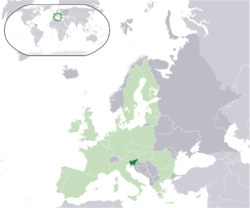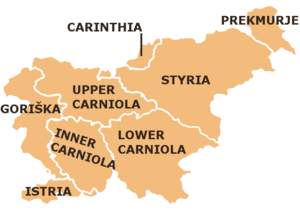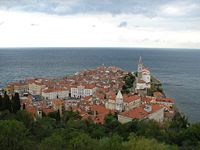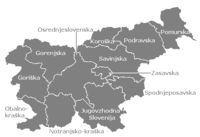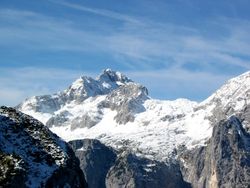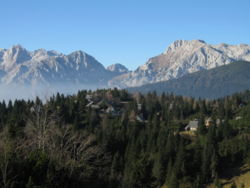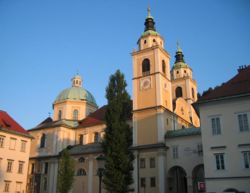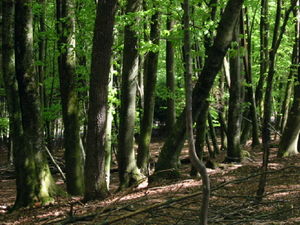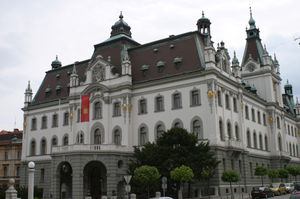Slovenia
2008/9 Schools Wikipedia Selection. Related subjects: Europe; European Countries
| Republika Slovenija Republic of Slovenia
|
||||||
|---|---|---|---|---|---|---|
|
||||||
| Anthem: 7th stanza of Zdravljica |
||||||
|
Location of Slovenia (dark green)
– on the European continent (light green & dark grey) |
||||||
| Capital (and largest city) |
Ljubljana |
|||||
| Official languages | Slovene1 | |||||
| Demonym | Slovenian, Slovene | |||||
| Government | Parliamentary republic | |||||
| - | President | Danilo Türk | ||||
| - | Prime Minister | Janez Janša | ||||
| Independence | from Yugoslavia | |||||
| - | Declared | June 25, 1991 | ||||
| - | Recognised | 1992 | ||||
| EU accession | May 1, 2004 | |||||
| Area | ||||||
| - | Total | 20,273 km² ( 153rd) 7,827 sq mi |
||||
| - | Water (%) | 0.6 | ||||
| Population | ||||||
| - | 2008 estimate | 2,023,358 2 ( 143rd) | ||||
| - | 2002 census | 1,964,036 | ||||
| - | Density | 99.6/km² ( 80th) 251/sq mi |
||||
| GDP ( PPP) | 2008 estimate | |||||
| - | Total | $48.343 billion ( 83rd) | ||||
| - | Per capita | $28,010 ( 29th) | ||||
| GDP (nominal) | 2007 estimate | |||||
| - | Total | $38.240 billion ( 67th) | ||||
| - | Per capita | $22,079 ( 30th) | ||||
| HDI (2005) | ▲ 0.917 (high) ( 27th) | |||||
| Currency | euro ( €)3 ( EUR) |
|||||
| Time zone | CET ( UTC+1) | |||||
| - | Summer ( DST) | CEST ( UTC+2) | ||||
| Internet TLD | .si4 | |||||
| Calling code | +386 | |||||
| 1 Italian and Hungarian are recognised as official languages in the residential municipalities of the Italian or Hungarian national community. 2 Source: Statistical Office of the Republic of Slovenia: Population, Slovenia, 30 June 2007 3 Prior to 2007: Slovenian tolar 4 Also .eu, shared with other European Union member states. |
||||||
Slovenia, officially the Republic of Slovenia ( Slovene: Republika Slovenija, listen ), is a country in southern Central Europe bordering Italy to the west, the Adriatic Sea to the southwest, Croatia to the south and east, Hungary to the northeast, and Austria to the north. The capital of Slovenia is Ljubljana.
At various points in Slovenia's history, the country has been part of the Roman Empire, the Byzantine Empire, the Republic of Venice, the Duchy of Carantania (only modern Slovenia's northern part), the Holy Roman Empire, the Habsburg Monarchy, the Austrian Empire (later known as Austria-Hungary), the State of Slovenes, Croats and Serbs, the Kingdom of Serbs, Croats and Slovenes (renamed to Kingdom of Yugoslavia in 1929) between the two World Wars, and the Socialist Federal Republic of Yugoslavia from 1945 until gaining independence in 1991.
Slovenia is the only former communist state to be at the same time a member of the European Union, the Eurozone, the Schengen area, the Organization for Security and Co-operation in Europe, the Council of Europe and NATO.
History
Slavic ancestors of the present-day Slovenes settled in the area in the 6th century. The Slavic Duchy of Carantania was formed in the 7th century. In 745, Carantania was incorporated into the Carolingian Empire, while Karantanians and other Slavs living in present Slovenia converted to Christianity. Carantania retained its internal independence until 828 when the local princes were deposed following the anti-Frankish rebellion of Ljudevit Posavski and replaced with a German (mostly Bavarian) ascendancy. Under the Emperor Arnulf of Carinthia Carantania, now ruled by a mixed Bavarian-Slav nobility, shortly emerged as a regional power, but was destroyed by the Hungarian invasions in the late 9th century. The Slovene Lands were turned into a military borderland of the Carolingian Empire (the Marches of Carinthia, of Carniola and of Friuli). Carantania was established again as an autonomous administrative unit in 976, but it never developed into a unified realm; it soon broke down into what became the duchies of Carinthia, Styria, Carniola and Friuli, into which the Slovene Lands remained divided up to 1918. The Carantanian identity remained alive into the 12th century when it was slowly replaced by regional identities. The first mentions of a common Slovene ethnic identity, transcending regional boundaries, date from the 16th century.
The Freising manuscripts, the earliest surviving written documents in a Slovene dialect as well as the oldest document written in any Slavic language with Latin script, were written in the 10th century. During the 14th century, most of Slovene Lands passed under Habsburg rule. In the 15th century, the Habsburg domination was challenged by the Counts of Celje, but by the end of the century the great majority of Slovene-inhabited territories were incorporated into the Habsburg Monarchy. Most Slovenes lived in the region known as Inner Austria, forming the majority of the population of the Duchy of Carniola and the County of Gorizia and Gradisca, as well as of Lower Styria and southern Carinthia. Slovenes also inhabited most of the territory of the Imperial Free City of Trieste, although representing the minority of its population. Slovene majorities also existed in the Prekmurje region of the Kingdom of Hungary, in the Venetian Slovenia and north-western Istria which were part of the Republic of Venice.
In the 16th century, the Protestant Reformation spread throughout the Slovene Lands. During this period, the first books in Slovene language were written by the Protestant preacher Primož Trubar and his followers, establishing the base for the development of the Slovene standard language. Although almost all Protestants were expelled from the Slovene Lands (with the exception of Prekmurje) by the beginning of the 17th century, they left a strong legacy in the tradition of the Slovene culture, which was partially incorporated in the Catholic Counter-Reformation. The Slovene cultural tradition was further reinforced in the Enlightenment period by the endeavours of the Zois Circle.
After a short French interim between 1805 and 1813, all Slovene Lands were included in the Austrian Empire. Slowly, a distinct Slovene national consciousness developed, and the quest for a political unification of all Slovenes became widespread. In 1848, a mass political and popular movement for the United Slovenia (Zedinjena Slovenija) emerged as part of the Spring of Nations movement within the Austrian Empire.
Between 1848 and 1918, numerous institutions (including theatres, publishing houses, as well as political, financial and cultural organisations) were founded in the so-called Slovene National Awakening; despite their political and institutional fragmentation and lack of a proper political representation, the Slovenes were able to establish a functioning and integrated national infrastructure. During this period, the town of Ljubljana, the capital of Carniola, emerged as the undisputed centre of all Slovene Lands, while the Slovenes developed an internationally comparable literature and culture. Nevertheless, the Slovene national question remained unsolved, so the political élite of the time started looking towards other Slavic nations in Austria-Hungary and the Balkans in order to engage in a common political action against German and Magyar hegemony. The idea of a common political entity of all South Slavs, known as Yugoslavia, emerged.
During World War I, after the Italian attack on Austria-Hungary in 1915, the Italian front opened, and some of the most important battles (the Battles of the Isonzo) were fought along the river Soča and on the Kras Plateau in the Slovenian Littoral.
With the collapse of the Austro-Hungarian Monarchy in 1918, the Slovenes initially joined the State of Slovenes, Croats and Serbs, which soon afterwards merged into the Kingdom of Serbs, Croats and Slovenes, later renamed to Kingdom of Yugoslavia. The western part of the Slovene Lands (the Slovenian Littoral and western districts of Inner Carniola) was annexed to the Kingdom of Italy and became known under the name of Julian March. In 1920, in the Carinthian Plebiscite, the majority of Carinthian Slovenes voted to remain in Austria. Although the Slovenes in the Kingdom of Yugoslavia were submitted to an intolerant centralist policy trying to eradicate a distinct Slovene national consciousness, they were still better off than Slovenes in Italy, Austria and Hungary, who became victims of policies of forced assimilation and violent persecution. As a reaction to the fascist violence of the Italian State in the Julian March, the organisation TIGR, regarded as one of the first armed antifascist resistance groups in Europe, was founded in 1927.
In April 1941, Yugoslavia was invaded by the Axis Powers. Slovenia was divided between Fascist Italy, Nazi Germany and Horthy's Hungary. Soon, a liberation movement under Communist leadership emerged. Due to political assassinations carried out by the Communist guerrillas as well as the pre-existing radical anti-Communism of the conservative circles of Slovenian society, a civil war between Slovenes broke out in the Italian-occupied south-eastern Slovenia (known as Province of Ljubljana) between the Liberation Front of the Slovenian People and the Axis-sponsored anti-communist militia, the Slovene Home Guard. Nevertheless, the Slovene partisan guerrilla managed to liberate large portions of the Slovene Lands, making an important contribution to the defeat of Nazism.
Following the re-establishment of Yugoslavia at the end of World War II, Slovenia became part of the Socialist Federal Republic of Yugoslavia, declared on 29 November 1945. A Communist dictatorship was established, but due to the Tito-Stalin split economic and personal freedom were better than in the Eastern Bloc. In 1947, Italy ceded most of the Julian March to Yugoslavia and Slovenia thus regained the Slovenian Littoral, including access to the sea. From the 1950s, the Socialist Republic of Slovenia enjoyed a relatively wide autonomy under the rule of the local Communist elite. In 1990, the first free and democratic elections were held and the DEMOS coalition defeated the former Communist parties. In December 1990, the overwhelming majority of Slovenian citizens voted for independence, which was declared on 25 June 1991. A Ten-Day War followed in which the Slovenians rejected Yugoslav military interference. After 1990, a stable democratic system evolved, with economic liberalisation and gradual growth of prosperity. Slovenia joined NATO on 29 March 2004 and the European Union on 1 May 2004. Slovenia is the first post-Communist country to hold the Presidency of the Council of the European Union, for the first six months of 2008.
Politics
The Slovenian head of state is the president, who is elected by popular vote every five years. The executive branch is headed by the prime minister and the council of ministers or cabinet, who are elected by the parliament.
The bicameral Parliament of Slovenia consists of the National Assembly (Državni zbor), and the National Council (Državni svet). The National Assembly has ninety members, 88 of which are elected by all the citizens in a system of proportional representation, while two are elected by the autochthonous Hungarian and Italian minorities. The National Council has forty members, appointed to represent social, economic, professional and local interest groups. Parliamentary elections are held every four years.
Administrative divisions
The traditional regions of Slovenia based on the former four Habsburg crown lands ( Carniola, Carinthia, Styria, and the Littoral) are the following:
| English name | Native name | |
| Upper Carniola | Gorenjska | |
| Styria | Štajerska | |
| Prekmurje | Prekmurje | |
| Carinthia | Koroška | |
| Inner Carniola | Notranjska | |
| Lower Carniola | Dolenjska | |
| Goriška | Goriška | |
| Slovenian Istria | Slovenska Istra |
Goriška and Slovenian Istria together are known as the Littoral region ( Slovene: Primorska). White Carniola ( Slovene: Bela krajina), otherwise part of Lower Carniola, is considered a separate region of Slovenia, as are Zasavje and Posavje, the former being a part of Upper Carniola, Lower Carniola and Styria; and the latter part of Lower Carniola and Styria.
Natural regions
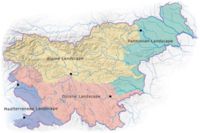
The first regionalisations of Slovenia were made by geographers Anton Melik (1935-1936) and Svetozar Ilešič (1968). The newer regionalisation by Ivan Gams divides Slovenia in the following macroregions:
- the Alps (visokogorske Alpe)
- the Prealpine Hills (predalpsko hribovje)
- the Ljubljana Basin (Ljubljanska kotlina)
- Submediterranean ( Littoral) Slovenia (submediteranska - primorska Slovenija)
- the Dinaric Karst of inner Slovenia (dinarski kras notranje Slovenije)
- Subpannonian Slovenia (subpanonska Slovenija)
According to a newer natural geographic regionalisation, the country consists of four macroregions. These are the Alpine, the Mediterranean, the Dinaric, and the Pannonian landscapes. Macroregions are defined according to major relief units (the Alps, the Pannonian plain, the Dinaric mountains) and climate types (submediterranean, temperate continental, mountain climate). These are often quite interwoven.
Macroregions consist of multiple and very diverse mesoregions. The main factor that defines them is the relief together with the geologic composition. Mesoregions in turn consist of numerous microregions.
Statistical regions
Slovenia's statistical regions exist solely for legal and statistical purposes. As of February 2007 there are 12 statistical regions (NUTS-2 level), which are grouped in two macroregions (NUTS-1 level):
|
|
The government, however, is preparing a plan for new administrative regions. The number of these regions is not yet defined, but is said to be between twelve and fourteen. After being unveiled publicly, the plan will undergo parliamentary debate. Constitutional changes allowing the creation of regions have already been approved by the National Assembly. If, however, twelve administrative regions are favored, they will most likely be the same as those already in place.
On May 24, 2007 the government proposed a reform in the local government system, introducing administrative regions with limited home rule. It has been stated that 13 will be the maximum allowed number of such regions (or provinces), but their actual names, territories and capitals have yet to be exactly determined. As the passage of necessary legislation has stalled, the process of devolution has been postponed, probably till 2010.
Municipalities
Slovenia is divided into 210 local municipalities, eleven of which have urban status.
Geography
Four major European geographic regions meet in Slovenia: the Alps, the Dinarides, the Pannonian plain, and the Mediterranean. Slovenia's highest peak is Triglav (2,864 m; 9,396 ft); the country's average height above sea level is 557 metres (1,827 ft). Around half of the country (11,691 km²; 4,514 sq mi) is covered by forests; the third most forested country in Europe, after Finland and Sweden. Remnants of primeval forests are still to be found, the largest in the Kočevje area. Grassland covers 5,593 square kilometres (2,159 sq mi) and fields and gardens 2,471 square kilometres (954 sq mi). There are 363 square kilometres (140 sq mi) of orchards and 216 square kilometres (83 sq mi) of vineyards.
Its climate is submediterranean on the coast, alpine in the mountains and continental with mild to hot summers and cold winters in the plateaux and valleys to the east. Average temperatures are -2 °C (28 °F) in January and 21 °C (70 °F) in July. The average rainfall is 1,000 millimetres (39.4 in) for the coast, up to 3,500 millimetres (137.8 in) for the Alps, 800 millimetres (31.5 in) for south-east and 1,400 millimetres (55.1 in) for central Slovenia.
Although on the shore of the Mediterranean Sea, most of Slovenia is in the Black Sea drainage basin. The geometric centre of gravity of Slovenia is at the geographic coordinates 46°07'11.8" N and 14°48'55.2" E. It lies in Spodnja Slivna near Vače in the municipality of Litija.
Economy
Slovenia has a high-income developed economy which enjoys the second highest (after Cyprus) GDP per capita ($28,010.76 estimate for 2008) of the new EU countries which is 93% of the EU average. Although the country's relatively high inflation declined to 2.3% in 2006 (prior to adoption of the euro), it recently reached 5.1% year-on-year, exceeding the average in the eurozone. Slovenia's economy has started to grow more strongly in the last few years (7.2% in first quarter of 2007, 5.7% in 2006, 4.1% in 2005), after relatively slow growth in 2003 (2.8%).
Despite economic success, Slovenia faces challenges. Much of the economy remains in state hands and foreign direct investment (FDI) in Slovenia is one of the lowest in the EU per capita. Taxes are relatively high, the labor market is seen as inflexible, and industries are losing sales to China, India, and elsewhere.
During the 2000s, privatisations were seen in the banking, telecommunications, and public utility sectors. Restrictions on foreign investment are being dismantled, and foreign direct investment (FDI) is expected to increase. Slovenia is the economic front-runner of the countries that joined the European Union in 2004 and the first new member to adopt the euro on 1 January 2007.
Numismatics
Slovenian euro coins were first issued for circulation on 1 January 2007 and feature a unique design for each coin. The Slovenian euro coins were the first to feature a new common side, with a new map of Europe on the bicoloured and Nordic-gold coins.
Since January 1, 2007, in such a short time, Slovenia have already built a small collection of collectors' coins, in gold, silver and other metals, with face value ranging from 3 to 100 euro. These coins are a legacy of an old national practice of minting of silver and gold commemorative coins. Unlike normal issues, these coins are not legal tender in all the eurozone. For instance, a €3 Slovenian commemorative coin cannot be used in any other country.
Demographics
-
- See also: Roman Catholicism in Slovenia, History of the Jews in Slovenia, and The erased immigrants ( Slovene: Izbrisani)
| Ethnic composition of Slovenia | ||||
|---|---|---|---|---|
| Slovene | 83.06% | |||
| Serbian | 1.98% | |||
| Croatian | 1.81% | |||
| Bosnian | 1.10% | |||
| Hungarian | 0.32% | |||
| Albanian | 0.31% | |||
| Macedonian | 0.20% | |||
| Romani | 0.17% | |||
| Montenegrin | 0.14% | |||
| Italian | 0.11% | |||
| other minorities | 1.9% | |||
| undeclared or unknown | 8.9% | |||
| source: 2002 census | ||||
Slovenia's main ethnic group is Slovene (83%). Nationalities from the former Yugoslavia ( Serbian, Croatian, Bosnian, Macedonian, Montenegrin) form 5.3%, and the Hungarian, Albanian, Roma, Italian and other minorities form 2.8% of the population. Ethnic affiliation of 8.9% was either undeclared or unknown.
Life expectancy in 2003 was 72.2 years for men and 80 years for women. Slovenia ranks number 8 on the list of countries by suicide rate.
| Religion in Slovenia | ||||
|---|---|---|---|---|
| Roman Catholic | 57.8% | |||
| undeclared or unknown | 22.8% | |||
| Atheist | 10.1% | |||
| Agnostic | 3.5% | |||
| Islam | 2.4% | |||
| Orthodox | 2.3% | |||
| Evangelical | 0.8% | |||
| other religions | 0.3% | |||
| Jewish | 0.0% | |||
| source: 2002 census | ||||
With 99 inhabitants per square kilometre (256/sq mi), Slovenia ranks low among the European countries in population density (compared to 320/km² (829/sq mi) for the Netherlands or 195/km² (505/sq mi) for Italy). The Notranjska-Kras statistical region has the lowest population density while the Central Slovenia has the highest. Approximately 51% of the population lives in urban areas and 49% in rural areas.
The official language is Slovene, which is a member of the South Slavic Slavic language group. Hungarian and Italian enjoy the status of official languages in the ethnically mixed regions along the Hungarian and Italian borders.
By religion, Slovenes are traditionally largely Roman Catholic (57.8% according to the 2002 Census). According to the most recent Eurobarometer Poll 2005, 37% of Slovenian citizens responded that "they believe there is a god", whereas 46% answered that "they believe there is some sort of spirit or life force" and 16% that "they do not believe there is any sort of spirit, god, or life force".
Culture
Slovenia's first book was printed by the Protestant reformer Primož Trubar (1508-1586). It was actually two books, Latin: Catechismus (a catechism) and Abecedarium, which was published in 1550 in Tübingen, Germany.
The central part of the country, namely Carniola (which existed as a part of Austria-Hungary until the early 20th century) was ethnographically and historically well-described in the book The Glory of the Duchy of Carniola (German: Die Ehre deß Herzogthums Crain, Slovene: Slava vojvodine Kranjske), published in 1689 by Baron Janez Vajkard Valvasor (1641-1693).
Some of Slovenia's greatest literates were the poets France Prešeren (1800-1849), Srečko Kosovel, Edvard Kocbek and Dane Zajc, as well as the writers Ivan Cankar (1876-1918) and Vladimir Bartol. Alojz Rebula, Drago Jančar, Boris Pahor, Tomaž Šalamun and Aleš Debeljak are the leading names of contemporary Slovene literature, while Aleš Šteger is one of the most noticeable name among newcomers. The most important Slovene painters include Anton Ažbe, Ivana Kobilca, Rihard Jakopič, Božidar Jakac, Avgust Černigoj and Zoran Mušič. The most famed Slovene architects are Jože Plečnik and Max Fabiani.
Slovenia is a homeland of numerous musicians and composers, including Renaissance composer Jacobus Gallus (1550-1591), who greatly influenced Central European classical music, and the violin virtuoso Giuseppe Tartini. In the twentieth century, Bojan Adamič was a renowned film music composer and Ivo Petrić (born June 16, 1931), is a composer of European classical music.
Contemporary popular musicians have been Slavko Avsenik, Laibach, Vlado Kreslin, Pero Lovšin, Pankrti, Zoran Predin, Lačni Franz, New Swing Quartet, DJ Umek, Valentino Kanzyani, Siddharta, Big Foot Mama, Terrafolk, Katalena, Magnifico and others.
Slovene cinema has more than a century-long tradition with Karol Grossmann, Janko Ravnik, Ferdo Delak, France Štiglic, Mirko Grobler, Igor Pretnar, France Kosmač, Jože Pogačnik, Matjaž Klopčič, Jane Kavčič, Jože Gale, Boštjan Hladnik and Karpo Godina as its most established filmmakers. Contemporary film directors Janez Burger, Jan Cvitkovič, Damjan Kozole, Janez Lapajne and Maja Weiss are most notable representatives of the so-called " Renaissance of Slovenian cinema".
Famous Slovene scholars include the chemist and Nobel prize laureate Friderik Pregl, physicist Jožef Stefan, philosophers Slavoj Žižek and Milan Komar, linguist Franc Miklošič, physician Anton Marko Plenčič, mathematician Jurij Vega, sociologist Thomas Luckmann, theologian Anton Strle and rocket engineer Herman Potočnik.
Biodiversity
Although Slovenia is a small country, there is an exceptionally wide variety of habitats. In the north of Slovenia are the Alps (namely, Julian Alps, Karavanke, Kamnik Alps), and in the south stand the Dinaric Alps. There is also a small area of the Pannonian plain and a Littoral Region. Much of southwestern Slovenia is characterized by Classical Karst, a very rich, often unexplored underground habitat containing diverse flora and fauna.
More than half of the country (about 58%) is covered by forests. These forests are an important natural resource, but they are also valuable for the preservation of natural diversity. An ecological asset like all forests, they enrich the soil and cleanse the water and air. Slovenes find the social benefits of tourism and recreation. The forests also lend their natural beauty to the Slovenian landscape. In the interior of the country there are typical Central European forests. The predominant trees are oaks and beeches. In the mountains, spruce, fir, and pine are more common. The tree line is at 1,700 to 1,800 metres (or 5,575 to 5,900 ft).
Pine trees also grow on the Kras plateau. Only one third of Kras is now covered by pine forest. Before that Kras was covered by oak forest. It is said that most of the forest was chopped down long ago to provide the wooden piles on which the city of Venice now stands. The Kras and White Carniola are well known for the mysterious proteus. The lime/linden tree, also common in Slovenian forests, is a national symbol.
In the Alps, flowers such as Daphne blagayana, various gentians ( Gentiana clusii, Gentiana froelichi), Primula auricula, edelweiss (the symbol of Slovene mountaineering), Cypripedium calceolus, Fritillaria meleagris (snake's head fritillary), and Pulsatilla grandis are found.
The country's fauna includes marmots, Alpine ibex, and chamois. There are numerous deer, roe deer, boar, and hares. The edible dormouse is often found in the Slovenian beech forests. Hunting these animals is a long tradition and is well described in the book The Glory of the Duchy of Carniola ( Slovene: Slava vojvodine Kranjske, 1689), written by Janez Vajkard Valvasor (1641-1693). Some important carnivores include the Eurasian lynx (reintroduced to the Kočevje area in 1973), European wild cats, foxes (especially the red fox), and the rare jackal. There are also hedgehogs, martens, and snakes such as vipers and grass snakes. As of March 2005, Slovenia also has a limited population of wolves and around four hundred brown bears.
There is a wide variety of birds, such as the Tawny Owl, the Long-eared Owl, the Eagle Owl, hawks, and Short-toed Eagles. Various other birds of prey have been recorded, as well as a growing number of ravens, crows and magpies migrating into Ljubljana and Maribor where they thrive. Other birds include (both Black and Green) Woodpeckers and the White Stork, which nests in Prekmurje.
The indigenous Slovenian fish is the marble trout or marmorata (Salmo marmoratus). Extensive breeding programmes have been introduced to repopulate the marble trout into lakes and streams invaded by non-indigenous species of trout.
The only regular species of cetaceans found in the northern Adriatic sea is the bottlenose dolphin (Tursiops truncatus).
Domestic animals originating in Slovenia include the Carniolan honeybee, the indigenous Karst Shepherd and the Lipizzan horse. The exploration of various cave systems has yielded discoveries of many cave-dwelling insects and other organisms.
Slovenia is a veritable cornucopia of forest, cavern and mountain-dwelling wildlife. Many species that are endangered or can no longer be found in other parts of Europe can still be found here.
Education
The Slovenian education system consists of:
- pre-school education
- basic education (single structure of primary and lower secondary education)
- (upper) secondary education: vocational and technical education, secondary general education
- higher vocational education
- higher education
Specific parts of the system:
- adult education
- music and dance education
- special needs education
- programmes in ethnically and linguistically mixed areas
Currently there are four universities in Slovenia:
- University of Ljubljana
- University of Maribor
- University of Primorska
- University of Nova Gorica
The Programme for International Student Assessment, coordinated by the OECD, currently ranks Slovenia's education as the 12th best in the world, being significantly higher than the OECD average.


